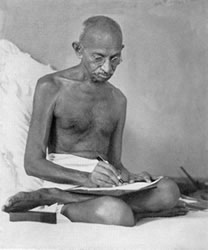
P.O. SEVAGRAM, DIST.WARDHA 442102, MS, INDIA. Phone: 91-7152-284753
FOUNDED BY MAHATMA GANDHI IN 1936
Short Stories For Everyone
Inspiring incidents from Gandhiji's Life: Selected from the book Everyone's Gandhi
(For the children in the age group of 10 to 15 years)

SHORT STORIES FOR EVERYONE
Gandhi's inspiring short stories selected from the book Everyone's Gandhi
Editor by : Rita Roy
Table of Contents
- All for A Stone
- A Car And A Pair of Binoculars
- My Master's Master
- Enter The Monkeys
- Premchand Quits His Job
- Returning His Medals
- Basic Pen
- Prisoner No. 1739
- Gandhi's White Brother
- Who Saw Gandhi?
- An Early School
- An Unusual March
- Spiritual Heir
- The Less You Have The More You Are
- An Old Goat Talks
- The Phoenix Settlement
- Gandhi in Amsterdam
- Something To Be Shy About?
- Gandhiji The Matchmaker
- Gandhi's Army
- Dandi Snippet
- Hiding Something
- The Image Maker
- Creative Reader
- Postcards To The Rescue
- A Non-violent Satyagraha 214 Years Ago
- Gandhi And Delhi
- Gandhiji's Constructive Programme
- Gandhi Looks At Leprosy
- Baba Amte
- They Gave Peace A Chance
- From Mahatma To God
- Customs Are Out of Fashion
- The Man 'Charlie' Wanted To Meet
- It Came Naturally To Him
- Crossing The Sea of Narrow-Mindedness
- Wear Clothes As They Should Be Worn
- Education: For Life, Through Life
- The Abode of Joy
- To Cling to A Belief
- The Fruit of A Child's Labour
- An Ideal Prisoner
- How A Film Became Something More
- Gandhi: Beyond India
- Gandhi's Life-Saving Medicine
- Understanding The Mechanics of Life With Gandhi
- The Lokmanya and The Mahatma
- Man's Gift To Nature
- Gurudev And His Mahatma
- One-man Boundary Force
- What Does Mahatma Gandhi's Message Mean To Me?
- Let's Play Together
- Children's Response To Conflict
- Beggar By Choice
- The Better Half
- Uncle Gandhi
- The Watch: An Instrument For Regulating Life
- Light The Lamp of Your Mind
- Gandhi's Bet!
- Gandhi Feeling At Home In The Kitchen
- What Is Simplicity?
- Bapu And The Sardar
- The Power of Quality
- Gandhi: The Teenager!
Chapter 20: Gandhi's Army
K.S. Narayanaswamy
Have you ever wondered how the hundreds and thousands who went on Satyagraha against the British were fed, clothed and housed? After all, most of them were in no position to earn money when they struggled against the rulers of the land. It was no small problem and the following piece gives some idea of how the nitty-gritty's were managed. This was when Gandhi the nonviolent actually went ahead and set up an "army" in South Africa.
It was October 1913 and a small town called Newcastle in the Natal Province of South Africa was overflowing with a crowd of Indian miners, their wives and children. They were mostly miners from Northern Natal who now had no homes of their own- for they were on strike and had given up the quarters provided by their masters. The strike was in protest against the unfair and crushing tax of three pounds that had been levied on them.
The miners and their families had no worldly goods except the clothes they wore and a few sundry blankets. A middle class Indian who had a small plot of land and a small house came forward to offer shelter. The house became a caravanserai and the kitchen fire knew no rest day and night. More and more people came trudging along the muddy roads in weather that had been bad. Soon the crowd increased to thousands. How were they to be housed and fed? There seemed a way out. Why not turn these pilgrims of faith into soldiers of Satyagraha? Why not take this "army" into the Transvaal and see them deposited in jails or settled at Tolstoy Farm where good Kallenbach would make the necessary arrangements? But the strength of the army was now about 5,000; there was no money for railway fare and the Transvaal border was distant indeed. Gandhiji decided to march on foot.
The miners had their wives and children with them but none of them would go back to the mines. "I had no alternative....," writes Gandhiji of that historic decision. The rules of the march were read out. There was to be a daily ration of only a pound and a half of bread and an ounce of sugar for each "soldier" They were not to keep more clothes than necessary, nor touch any one's property on the way. They were to welcome arrest, bear patiently with abuse, and even flogging.
On 28 October the caravan started on its march and safely reached Charlestown, a small border town of 1,000 people, where only the women and children could be lodged. The rest camped in the open and did their scavenging and sweeping. More labourers arrived from Newcastle and the kitchen was active all the twenty-four hours. The ration now consisted of rice and dal. But there were hungry looks and the organisers had their limitations. Gandhiji was the leader among the cooks and assumed the thankless task of serving the food. There was either too much water in the dal (pulses) or the food was insufficiently cooked but the army gulped it down cheerfully.
From Tours and Marches by M. Chalapathi Rao